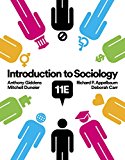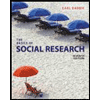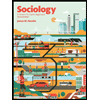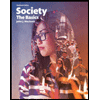
Introduction
A social group is a set of people who interact regularly due to shared interests. A social aggregate is a group of people who happen to be in the same place at the same time.
Explanation of Solution
Answer and explanation
Social groups are comprised of people who share interests and interact regularly, like a bowling team or sewing circle. The people on the team share an interest in the sport, and they gather regularly to play and socialize, while those in the sewing circle share a hobby and spend time together engaged in that activity. A social aggregate is comprised of people who are in the same place at the same time, but not necessarily interacting. For example, people on a subway train are all commuting, but they are not all there to interact with each other. They may share some interests, but that is not why they are on the train.
Want to see more full solutions like this?
Chapter 6 Solutions
EBK INTRODUCTION TO SOCIOLOGY (SEAGULL
- video "SDG's aren't the same old, same old." What are SDG's? Sustainable Development Goals or "Global Goals" created by the United Nations (UN) https://www.youtube.com/watch?v=v7WUpgPZzpI&t=4s Describe at least 3 of the Global Goals mentioned in the video.arrow_forwardWatch the following video about early intervention for children with visual impairments: (its 10 minutes long) http://www.youtube.com/watch?v=6rbHOAtBNew After watching the video, consider the following: How were parents and family members involved in the early interventions offered to their child? Why was this involvement important? What sort of interventions were used? How were these beneficial?arrow_forwardSimple/ humanized answers: How has the field of education for students with visual impairments (low vision and blindness) evolved? What is the definition of “visual impairment,” how are students identified, and what are the typical causes of visual impairments? Why is early intervention so critical for children with visual impairments, and how can families support children with visual impairments? What are some specific concerns for culturally and/or linguistically diverse children with visual impairments? What kinds of educational responses are needed to address the needs of students with visual impairments?arrow_forward
- How do minor parties influence the U.S. electoral system?arrow_forwardeelancer X English task 1.pdf - Google Driv X kq_A8Yyhcg5Muq83vtY5jmlvjd6ITE/view + Open with Google Docs Task Requirements: Word Count: 300-400 Formatting Style: MLA (for more information click here) *** A minimum of 1 reliable source must be used! Any sources must be properly cited according to the formatting style assigned Many people disagree about the appropriate age to allow children and young adults to use social media. Write an essay that argues your viewpoint about the issue. Develop your claim with reasons and evidence, and form a rebuttal to argue against a counterclaim. Page 1 / 1 Q + 26°C Mcarrow_forwardDCS cans certification exam answers micaharrow_forward
- Describe a business that has used backcasting or scenarios to assess a situation and then developed a strategy to achieve their goals? what are the obstacles they faced ?arrow_forwardWhy could Backcasting be considered the most useful futuring method? how does the use of modules and simulations relate to futuring? is this method effective?arrow_forward"Literature is able to challenge perceptions by capturing the voices of frequently silenced characters". In the light of this comment show how Alexander Masters is successful in promoting Stuart's voice in Stuart: Alfie backwards. Include any quotes which are relevant.arrow_forward
 Social Psychology (10th Edition)SociologyISBN:9780134641287Author:Elliot Aronson, Timothy D. Wilson, Robin M. Akert, Samuel R. SommersPublisher:Pearson College Div
Social Psychology (10th Edition)SociologyISBN:9780134641287Author:Elliot Aronson, Timothy D. Wilson, Robin M. Akert, Samuel R. SommersPublisher:Pearson College Div Introduction to Sociology (Eleventh Edition)SociologyISBN:9780393639407Author:Deborah Carr, Anthony Giddens, Mitchell Duneier, Richard P. AppelbaumPublisher:W. W. Norton & Company
Introduction to Sociology (Eleventh Edition)SociologyISBN:9780393639407Author:Deborah Carr, Anthony Giddens, Mitchell Duneier, Richard P. AppelbaumPublisher:W. W. Norton & Company The Basics of Social Research (MindTap Course Lis...SociologyISBN:9781305503076Author:Earl R. BabbiePublisher:Cengage Learning
The Basics of Social Research (MindTap Course Lis...SociologyISBN:9781305503076Author:Earl R. BabbiePublisher:Cengage Learning Criminalistics: An Introduction to Forensic Scien...SociologyISBN:9780134477596Author:Saferstein, RichardPublisher:PEARSON
Criminalistics: An Introduction to Forensic Scien...SociologyISBN:9780134477596Author:Saferstein, RichardPublisher:PEARSON Sociology: A Down-to-Earth Approach (13th Edition)SociologyISBN:9780134205571Author:James M. HenslinPublisher:PEARSON
Sociology: A Down-to-Earth Approach (13th Edition)SociologyISBN:9780134205571Author:James M. HenslinPublisher:PEARSON Society: The Basics (14th Edition)SociologyISBN:9780134206325Author:John J. MacionisPublisher:PEARSON
Society: The Basics (14th Edition)SociologyISBN:9780134206325Author:John J. MacionisPublisher:PEARSON





